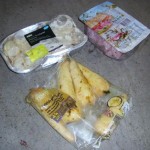Launch of Green Johannas at Bishop Luffa School, Chichester.

 In May, Carrie from Sussex Green Living and Blanca Timblick, the Business Enterprise Co-ordinator at Bishop Luffa School, launched Green Johanna’s at the school. Blanca and Carrie trained with Better Tomorrows CIC earlier in the year to become voluntary Waste Prevention Advisors. Better Tomorrows’ aim is to change how the residents of West Sussex think and behave in order to be more environmentally-friendly and more sustainable.
In May, Carrie from Sussex Green Living and Blanca Timblick, the Business Enterprise Co-ordinator at Bishop Luffa School, launched Green Johanna’s at the school. Blanca and Carrie trained with Better Tomorrows CIC earlier in the year to become voluntary Waste Prevention Advisors. Better Tomorrows’ aim is to change how the residents of West Sussex think and behave in order to be more environmentally-friendly and more sustainable.

 The Bishop Luffa training session was to 25 year 8 Food Technology pupils. The session looked at Food Waste based on the government department WRAP’s initiative Love Food Hate Waste and highlighted the effects of food packaging and over-consumption from an environmental perspective, emphasising why we must reduce, reuse and recycle. The students watched this video Family video on composting using a Green Johanna.
The Bishop Luffa training session was to 25 year 8 Food Technology pupils. The session looked at Food Waste based on the government department WRAP’s initiative Love Food Hate Waste and highlighted the effects of food packaging and over-consumption from an environmental perspective, emphasising why we must reduce, reuse and recycle. The students watched this video Family video on composting using a Green Johanna.
Bishop Luffa have installed four Green Johannas into the school and are planning on introducing more. They also aim to run more of these training sessions with other students. Blanca says: “This was the launch of a whole school initiative involving teachers, members of staff and all pupils/students to reduce waste and encourage recycling”.
Some shocking UK food waste stats and facts:

 84% of us believe we throw none or hardly any food away!
84% of us believe we throw none or hardly any food away!
UK households throw away 8.3 million tonnes of food and drink every year…of this:
Avoidable food and drink waste = 5.3 million tonnes.
Possibly avoidable food and drink waste = 1.5 million tonnes.
Unavoidable food and drink waste = 1.5 million tonnes (fruit and vegetable peelings, tea bags, egg shells etc).
£11.5 billion worth of avoidable food and drink waste equates to £480 per year for the average household, rising to around £680 per year for families with children, or £50 a month.
Where does this food waste go?
Household kerbside waste and recycling and HWRCs – 5.8 million tonnes per annum. (As there is not a food waste collection or recycling service in West Sussex, any waste currently has to go into the landfill.)
Sewer – 1.8 million tonnes per annum
Home composting and fed to animals – 0.7 million tonnes per annum.
Avoidable Food and Drink waste is responsible for the equivalent of 20 million tonnes of carbon dioxide equivalents– that’s like taking 25% of cars off our roads.
Wasted food isn’t just a waste of money, it has a big impact on climate change too. Most of the food ends up at landfill sites where it rots and releases methane, a damaging greenhouse gas. Throwing food away is a huge waste of the energy, water and packaging used in its production, transportation and storage.
Why don’t you return the valuable nutrients from unavoidable food waste to the Earth, your garden, within 6 months using a Green Johanna. Find out more about Green Johanna and purchase one here.
To see the Love Food Hate Waste presentation and information on how to avoid food waste and save money, become a member of Sussex Green Living (it’s free), then you will have access to the presentation in the members download section.
